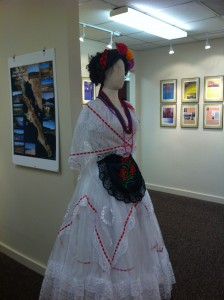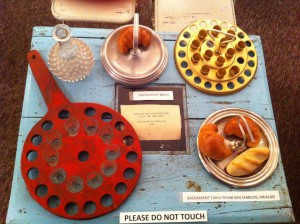
One man’s passion to collect the history of the first Mormon Mexicans in the LDS Church and share it with the world has brought about the Mormon Mexican Museum in Provo.
Fernando Gomez followed the legacy of his aunt Consuelo Gomez Gonzalez and collected hundreds of artifacts and accounts of his ancestors who joined the Church in the late 1800s. His dream came true when he opened the Museum of Mormon Mexican History in Provo in 2011.
“Fernando’s aunt Consuelo was the original curator of the museum,” said James Mitchell, Fernando Gomez’s grandson-in-law, who helps with the museum. “She gathered all of the history first, and then after a successful career in technology, Fernando followed suit. When people in the Mexican community heard about his efforts, donations and new stuff for the museum came flooding in.”
The exhibit details the history of the Church starting in Mexico. A whole room is dedicated to the timeline of the conversion of Mexican Saints. Visitors can also see sacrament trays and cups from the 1930s, original newspapers from that time and one of the first genealogy books. Traditional dresses worn by Mexican Saints were also donated. They show how the Saints dressed daily or at celebration.
One particular story that sticks out to visitors is the story of the translation of the Book of Mormon into Spanish.
“The first missionaries in Mexico were told by Brigham Young to ‘scout out the land,'” Mitchell said. “They didn’t even have a Spanish Book of Mormon yet; they weren’t having any luck.”
Meliton Gonzalez Trejo was a well-educated military student who held high prestige in his community in Spain. He had many questions about religion. As he investigated religion and God, his studies held no answers. He was inspired to go to the Rocky Mountains, and in a dream he saw that he needed to find Brigham Young. Because of his education, and by following the Spirit, Trejo translated the Book of Mormon into Spanish with Daniel W. Jones and James Zebulon Stewart.
“At the museum people get to learn things they don’t usually hear in a Church lesson about pioneers or the early beginnings of the Church,” Mitchell said.
One visitor, Mary Moronelli, from Uruguay, was visiting Utah for a wedding when she passed the museum and decided to stop by.
“I always wondered how the Church grew in Mexico,” Moronelli said through a translator. “I thought the Church started in the U.S. and went to South America and worked its way up. I had no idea it spread from the U.S. to Mexico first. It was a spiritual experience to learn that. I’m so glad I stopped by.”
The museum is a great educational experience for people who don’t know a lot about the growth of the Church in other countries.

“I think these museums are great for people to see,” said Sarah Hall, a BYU student from Del Rio, Texas, who grew up surrounded by Hispanic culture. “Because if you go to a regular Church history museum you might just see things about the original pioneers who crossed the plains. But in a sense the history of the Latin culture is about pioneers as well. The first members in Mexico who started branches have their own history of being pioneers, even though you don’t see them as the typical ‘1847’ pioneers.”
The museum isn’t just for Mexican-American Mormons who want to know more about their heritage. It’s for anyone who wants to see the roots and growth of the gospel to other peoples and cultures. Spanish teachers at BYU have encouraged students to visit the museum for class assignments and experiences.
“I gave a tour to a girl who found a name of one of her ancestors in our exhibit,” Mitchell said. “She went home and did research. She found out that her family was one of the first Mormon families to live in Mexico. It’s cool how this museum can connect people to their own family history.”
Connecting people to the gospel and its growth and history is the exact goal Gomez had for the museum. The museum is a success among Spanish-speaking people in the area and returned missionaries.
“We unite the past with the present in order to strengthen the gospel bonds of the Restoration,” Gomez said.
The museum is free to the public and is open Tuesday–Friday from 2 to 6 p.m. and on Saturdays from 10 a.m. to 6 p.m.. For more information, call 801-830-1468 or visit the museum on 1501 N. Canyon Road in Provo.




